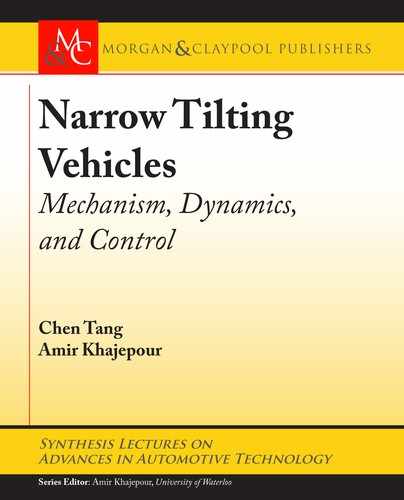
3.4. SUSPENSION DESIGNS FOR NTV STABILITY 25
x
D
j
z
1
DCz; z
2
Dz
D arctan
2z
T
w0
: (3.22)
Under a pure-tilting condition, as suggested by Eq. (3.22), longitudinal movements (x
1
and x
2
) introduced by the trailing arm suspensions will not affect the tilting angle. e angle
can be determined by using the simplified roll plane model as adopted in previous sections.
However, once the no-pitch condition Eq. (3.21) does not hold, the general rotation angle
solved from Eq. (3.19) should be considered, and both longitudinal and vertical movement of
the wheels can affect the final tilting angle.
3.4.2 LOAD DISTRIBUTION ANALYSIS
Apart from direct impacts on motion states (e.g., ), suspension kinematics could also change
normal force distributions of NTVs due to movements of contact patches as imposed by suspen-
sion tilting mechanisms. LTR index derived in Section 3.2 is adopted as the stability measure
to analyze the impact of wheel movements on vehicle rollover stability. A tadpole-configured
NTV with trailing-arm suspension is illustrated in Figure 3.4 for this analysis.
A quasi-static assumption is adopted which applies inertia forces ma
x
; ma
y
at center-of-
gravity of the NTV, and the tilting angle is set to its steady-state value
x
. To balance positive a
y
disturbances, the vehicle should lean to the left, with its left wheel being lifted and right wheel
pushed downward, as shown in the figure.
Using D’Alembert’s principle, the equilibrium considering wheel movements imposed by
suspension mechanisms is derived as
8
ˆ
ˆ
<
ˆ
ˆ
:
F
z1
C F
z2
C F
z3
D mg
mgh
0
sin
.
x
/
C ma
y
h
0
cos
.
x
/
C
.
F
z1
F
z2
/
T
w
2
D 0
ma
x
h
0
cos
.
x
/
C F
z1
.
a C x
1
/
C F
z2
.
a C x
2
/
F
z3
.
b
/
D 0:
(3.23)
Normal loads on each tire can then be solved from Eq. (3.23) as
8
ˆ
ˆ
ˆ
<
ˆ
ˆ
ˆ
:
F
z1
D
b
2l
mg
mh
2l
a
x
l
0
Cx
2
l
mh
T
w0
a
ynb
F
z2
D
b
2l
mg
mh
2l
a
x
C
l
0
Cx
1
l
mh
T
w0
a
ynb
F
z3
D
aC
.
x
1
Cx
2
/=
2
l
mg C
mh
l
a
x
x
1
x
2
l
mh
T
w0
a
ynb
; (3.24)
where l
0
is the nominal wheelbase l
0
D a C b; l is the actual wheelbase considering wheel longi-
tudinal movements during tilting; and a
ynb
is the unbalanced lateral acceleration by subtracting
the gravity-balanced terms:

26 3. TILTING VEHICLE DYNAMICS
Y
Z'
Z
X
O
ma
y
ma
x
mg
φ
x
F
z
F
x
F
y
F
y3
F
z3
F
x3
F
z
F
x
F
y
Figure 3.4: Force analysis of NTV in tilting [24]. (Image used with permission.)
l D l
0
C
x
1
C x
2
2
a
ynb
D a
y
cos
.
x
/
C g sin
.
x
/
:
(3.25)
It is shown in Eq. (3.24) that wheel motions enforced by suspension mechanisms do effect
normal load distributions. To quantify its impact, LTR [49, 50] can be solved using normal forces
determined on front wheels as
LTR D
.
x
1
C x
2
/=
2 C l
0
.
x
1
x
2
/=
2 C p
(3.26)
with
p D
1
2
a
x
g
h b
a
ynb
g
h
T
w
0
:
Compared with this general LTR index considering the impacts of suspension kinematics,
the classical roll-plane LTR index in previous sections can be treated as a special case with
x
1
D x
2
D 0.
..................Content has been hidden....................
You can't read the all page of ebook, please click here login for view all page.
